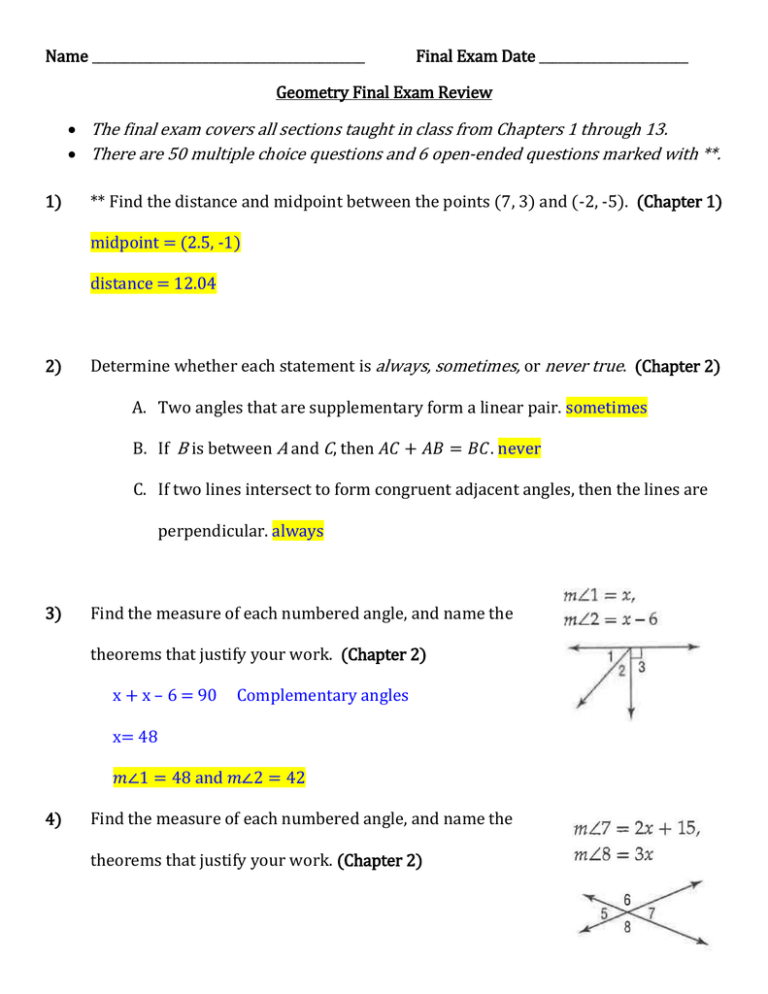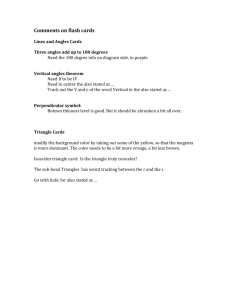Final Review Packet ANSWER KEY
advertisement

Name __________________________________________ Final Exam Date _______________________ Geometry Final Exam Review The final exam covers all sections taught in class from Chapters 1 through 13. There are 50 multiple choice questions and 6 open-ended questions marked with **. 1) ** Find the distance and midpoint between the points (7, 3) and (-2, -5). (Chapter 1) midpoint = (2.5, -1) distance = 12.04 2) Determine whether each statement is always, sometimes, or never true. (Chapter 2) A. Two angles that are supplementary form a linear pair. sometimes B. If B is between A and C, then 𝐴𝐶 + 𝐴𝐵 = 𝐵𝐶. never C. If two lines intersect to form congruent adjacent angles, then the lines are perpendicular. always 3) Find the measure of each numbered angle, and name the theorems that justify your work. (Chapter 2) x + x – 6 = 90 Complementary angles x= 48 𝑚∠1 = 48 and 𝑚∠2 = 42 4) Find the measure of each numbered angle, and name the theorems that justify your work. (Chapter 2) Linear pairs are supplementary 2𝑥 + 15 + 3𝑥 = 180 therefore 𝑥 = 33 and 𝑚∠7 = 81 and 𝑚∠8 = 99 5) ** Use the diagram to the right. (Chapter 2) ̅̅̅̅ . a) Find the length of 𝐴𝐶 𝑥 + 2𝑥 = 2𝑥 + 5 so 𝑥 = 5 and 𝐴𝐶 = 15 ̅̅̅̅ , what is the probability that it is on ̅̅̅̅ b) If a point is randomly chosen on 𝐴𝐶 𝐵𝐶 . ̅̅̅̅ ) = 𝐵𝐶 = 10 𝑠𝑜 𝑃(𝐵𝐶 6) 10 2 = 15 3 ̅̅̅̅ 𝐻𝐺 and ̅̅̅̅ 𝐸𝐺 are parallel. (Chapter 3) a) If 𝑚∠𝐸𝐹𝐷 = 2𝑥 + 1 and 𝑚∠𝐻𝐼𝐾 = 130, what is the value of x? Same side exterior angles are supplementary 2𝑥 + 1 + 130 = 180 so 𝑥 = 24.5 b) What theorem proves that ∠𝐺𝐹𝐼 and ∠𝐽𝐼𝐾 are congruent? Corresponding angle theorem 7) Find the slope of the line parallel to 4𝑥 − 3𝑦 = 2. (Chapter 3) 𝑚= 8) 4 3 If 𝑚∠𝐾𝐼𝐽 = 60, 𝑚∠𝐸𝐹𝐷 = 5𝑦, and 𝑚∠𝐼𝐹𝐺 = 5𝑥 − 10, what is the value of x? (Chapter 3) Corresponding angles 60 = 5𝑥 − 10 so 𝑥 = 14 9) In the diagram, ∆𝑅𝑆𝑇 ≅ ∆𝑋𝑌𝑍. Find 𝑥 and 𝑦. (Chapter 4) 4𝑦 − 10 = 3𝑦 + 5 so 𝑦 = 15 𝑥 + 21 = 2𝑥 − 14 so 𝑥 = 35 10) ** Complete the proof. (Chapter 4) 11) Determine which postulate or theorem can be used to prove each pair of triangles congruent. If it is not possible to prove them congruent, write not possible. (Chapter 4) a) b) c) d) AAS SSS No SAS e) f) SSS 12) g) h) ASA AAS Given: Vertical isosceles triangles; ̅̅̅̅ 𝑅𝑆 bisects ̅̅̅̅ 𝑄𝑇; ∠𝑅 ≅ ∠𝑆 Prove: △ 𝑄𝑅𝑃 ≅ Δ𝑇𝑆𝑃 (Chapter 4) SAS 13) Determine whether each statement is always, sometimes, or never true. (Chapter 4) a) The Pythagorean Theorem does not apply to right triangles. Never b) Right triangles can be equilateral. Never c) The sum of the interior angles of a right triangle is 90 degrees. Never d) Right triangles are isosceles triangles. Sometimes 14) List the angles in the triangles from least to greatest. (Chapter 5) C, B, A 15) Match each term with the correct picture. (Chapter 5) a) Perpendicular bisector b) Angle bisector iii c) Median i d) Altitude ii iv 16) If 𝐷𝐸 = 14 + 2𝑥 and 𝐺𝐹 = 4(𝑥 − 3) + 6, find 𝐺𝐹. (Chapter 6) 14 + 2𝑥 = 4(𝑥 − 3) + 6 so 𝑥 = 10; GF=34 17) Determine whether each statement is always, sometimes, or never true. (Chapter 6) a) In a parallelogram, opposite sides are congruent. Always b) In a parallelogram, opposite angles are congruent. Always c) In a parallelogram, consecutive angles are complementary. Never 18) Find the value of x if the vertices of a parallelogram are (−2, −4), (−3, −7, (2, −5), and (𝑥, −2). (Chapter 6) x=3 19) Find x in the trapezoid below. (Chapter 6) x=130 20) Determine whether the pair of figures is similar. If so, write the similarity statement and scale factor. If not, explain your reasoning. (Chapter 7) 𝚫𝐗𝐘𝐙~𝚫𝐀𝐁𝐂 and 𝑺𝒄𝒂𝒍𝒆 𝑭𝒂𝒄𝒕𝒐𝒓 = 21) 𝟐 𝟕 ̅̅̅̅ and E is the midpoint of 𝐵𝐶 ̅̅̅̅ , If D is the midpoint of 𝐴𝐶 find the length of ̅̅̅̅ 𝐴𝐵. (Chapter 7) 14 22) ** The two sail boats below form right triangles. Are these two right triangles similar? Show your work and write an explanation to justify your answer. (Chapter 7) 𝒄𝒐𝒔 𝟒𝟎 = 𝒙 → 𝒙 = 𝟐𝟎𝟐. 𝟐 𝟐𝟔𝟒 𝟏𝟔𝟖. 𝟓 𝟐𝟐𝟎 = = 𝟎. 𝟖𝟑𝟑𝟑 𝟐𝟎𝟐. 𝟐 𝟐𝟔𝟒 Triangles are similar by SAS orAA. 23) (Chapter 7) 7.5 𝑃𝑆 = 3 2.5 PS=6.25 24) ̅̅̅̅. (Chapter 7) If ΔMQN~ΔMPO, find 𝑄𝑃 3 25) (Chapter 7) 𝑡 = 3 and 𝐶𝐸 = 1 26) If ΔLMN~ΔXYZ, find 𝑚∠𝑍. (Chapter 7) 40 27) A wall with a height of 7.5 meter casts a shadow 12 meter long. How high is pole that casts a shadow of 60 meters long? (Chapter 7) 37.5 m 28) Find 𝑥, 𝑦, and 𝑧. (Chapter 8) 𝑥 = 6, 𝑦 = 7.2, 𝑧 = 10.8 29) Find the height of the airplane pictured (all measurements in meters). (Chapter 8) 500 meters 30) If you are standing at point C, how far away are you from the tree? Round to the tenths. (Chapter 8) 42.8 feet 31) Name three possible side lengths of a right triangle. (Chapter 8) 3, 4, 5 32) Write the ratio of cos 𝐽. (Chapter 8) 12 13 33) Suppose you're flying a kite, and it gets caught at the top of a tree. You've let out all 100 feet of string for the kite, and the angle that the string makes with the ground (the angle of elevation) is 75 degrees. What is the height of the tree? Round to the tenths. (Chapter 8) 96.6 feet 34) An isosceles right triangle has an area of 50 square inches. What is the length of the hypotenuse in inches? (Chapter 8) 14.1 inches 35) Find the width of the rectangle. Round to the nearest tenths. (Chapter 8) 9.8 cm 36) A kite is being flown and gets caught in the power lines. If the kite string makes a 45 degree angle with the ground and you are standing 10 feet away from the power lines, how long is the kite string? Round to the nearest foot. (Chapter 8) 14 feet 37) Does a triangle with side lengths 5, 12, and 13 form a right triangle? (Chapter 8) yes 38) An equilateral triangle has a side length of 5. What is the measure, in inches, of its altitude? Round to the hundredths. (Chapter 8) 4.33 inches 39) Find 𝑦 to the nearest tenth. (Chapter 8) 𝑦 = 6.7 40) Find the altitude of the right triangle drawn to the hypotenuse. (Chapter 8) 7.5 41) Use a calculator to find the measure of angle R to the nearest tenth. (Chapter 8) a) 42) 70.9 b) 39.6 ** Use the grid to the right to answer the following questions. (Chapter 9) a) On the grid above, draw a reflection of figure F over the y-axis to form figure F’. b) Draw a reflection of figure F’ over the x-axis to form figure F”. c) In the space below, describe another transformation or a set of transformations that would transform figure F to figure F”. Rotation of 180 degrees 43) ** Graph the concentric circles with center at (2,0) and radii of 1 and 3 on the graph below. (Chapter 10) a) Write the standard form of the equation of the equation of the circle for both circles. (𝑥 − 2)2 + 𝑦 2 = 1 and (𝑥 − 2)2 + 𝑦 2 = 9 b) What is the probability that a randomly thrown dart will land inside the smaller circle? 1 9 44) The circumference of a circle is 10 feet. If the length of the diameter is double, what is the new circumference, to the closest foot? (Chapter 10) 20 feet 45) Find the area of each figure. Round to the nearest tenth if necessary. (Chapter 11) a) b) 54 46) c) 21 52.5 𝑐𝑚2 A geometric figure is cut up and laid flat, as shown on the right. What geometric figure would most closely resemble the geometric figure put back together? (Chapter 12) cylinder 47) Find the volume of each prism or cylinder. Round your answer to the nearest tenth. (Chapter 12) a) b) 2,304 𝑐𝑚3 48) 16,257.74 𝑚𝑚3 ̅̅̅̅ . Find the Point X is chosen at random on 𝐴𝐸 probability of each event. (Chapter 13) ̅̅̅̅ ) a) 𝑃(𝑋 𝑖𝑠 𝑜𝑛 𝐴𝐶 18 9 = 40 20 b) 𝑃(𝑋 𝑖𝑠 𝑜𝑛 ̅̅̅̅ 𝐶𝐷) 15 3 = 40 8 49) Find the area of the UNSHADED region of the circle. (Chapter 13) 21𝜋





